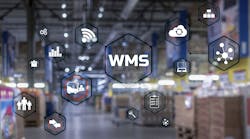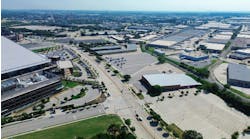The pandemic has driven the logistics and transportation industries to feel the sting of labor shortages, workforce retention challenges and higher overhead costs. In addition, the retail ecosystem has had to accelerate its transformation, as it caters to a consumer whose omnichannel shopping expectations have never been higher. Not to mention, warehouses are running at or dangerously near the top of their capacity where stock is concerned, with companies stockpiling inventory to avoid shortage of goods.
All these factors result in heightened complexity for companies’ supply chains, where the warehouse plays an increasingly critical role. The need to future-proof the distribution center (DC) is immediate—the faster operations prepare for it, the easier it will be to adapt to the demands of today and those in the future. Here are five ways the right warehouse management system (WMS) can maximize the efficiency and adaptability of the warehouse:
1. Migrating to Cloud-Native Solutions
Geopolitical shifts and the pandemic have made the global supply chain increasingly unpredictable and complex. Today’s ecosystem demands cloud-native solutions that are flexible and offer continuous innovation, meaning they do not stagnate as legacy-versioned software ages. Doing so eliminates the need for costly, time-consuming software upgrades and offers instant access to new capabilities which can be delivered on a regular cadence.
Cloud-native technology is engineered to handle the natural surges and recessions of demand which most businesses encounter, especially those with seasonal demand spikes around holidays or other events. The ability to scale up or down as demand changes helps ensure supply chains continue to run at peak performance while keeping costs in check.
2. Adopting a Platform with a Microservices Architecture
Solutions need to be purposefully built so different systems can work in conjunction with each other. Platforms that are engineered entirely from microservices are resilient and deliver constant innovation, along with extensibility, scalability and availability.
This type of architecture also allows supply chain commerce to be broken down into discrete functional components that can be assembled to create new experiences. It also eliminates redundancy because every component is part of a shared application platform, enabling seamless upgrades on a regular basis.
3. Unifying the Supply Chain
Modern, cloud-native technology is the key for unified solutions to work together instead of functioning in silos, offering manufacturers, distributors and retailers complete visibility into the product’s journey. From order placement, to shipment, to delivery, a seamless supply chain is only possible when systems built for warehouse, transportation, inventory and order management work seamlessly with each other in real-time rather than via rigid and antiquated interfaces.
Unification also opens the door to agility and flexibility. Unified applications allow transportation to plan and continuously refine the plan as operations proceed in the warehouse. As exceptions occur such as inventory shortages or if actual weights/volumes do not match initial estimates, transportation can refine the plan immediately and ensure trailers are fully utilized, eliminating all the rushed manual intervention that attempts to fill up empty space.
A unified approach to planning and execution also enables visibility along with the ability to proactively take action before issues arise. Unification helps eliminate costly integration and ensures that previously disparate applications operate in unison, driving lower transportation costs, reducing dwell time of trailers, reducing detention charges of trailers waiting to be loaded/unloaded, and providing insight so that warehouse labor plans may be optimized.
4. Driving Efficiency with Robotics and Automation
The growth of robotics and automation in the warehouse started prior to COVID. However, the labor shortages of the pandemic led to an explosion of these technologies. The key going forward is to orchestrate people, processes and automation together. Rather than replace the workforce, robotics complements it. Robots can handle mundane, repetitive tasks that do not require decision-making, enabling humans to use their time more efficiently.
As just one example, look at autonomous mobile robotics (AMRs), also called collaborative picking bots. Historically a person would visit various locations and pick items into a shippable LPN. Inevitably, that process would involve significant travel around the warehouse. To the distribution operation, the pick is what’s valuable while the travel required between picking locations is a cost. AMRs can improve the utilization of the worker by reducing the travel and enabling more picking.
In terms of technology, the key is having a WMS with a warehouse execution system (WES) built in. That ensures DCs can integrate any combination of automation and robotics, both today and tomorrow.
5. Enhancing Human Efficiency with Gamification
Faced with labor shortages and greater competition for workers, it is critical that warehouses maximize employee productivity and engagement. This requires modern, intuitive user interfaces that reduce onboarding times, improve work experiences and increase motivation. Gamification, similar to the smartphone apps we all play, can deliver those benefits by combining human psychology with technology. Companies that have leveraged these tools have seen significant reduction in training costs associated with new hires and increased worker productivity.
At the same time, modern WMS solutions also provide supervisors with a host of new ways to monitor performance, solve problems, shift priorities and maintain critical SLAs, every hour of every day. Given the workforce shortages and turnover, DCs cannot afford installed WMS user tools that prove to be complicated and require extensive employee training. This is where cloud-native employee tools have an edge—they can deliver feature modern interfaces and deliver user experiences that today’s workforce is familiar with, reducing training time and increasing productivity.
To conclude, companies are operating in a fast-moving, constantly transforming supply chain environment. To meet demands and remain competitive, distribution operations need greater efficiency and adaptability than ever. That’s why industry leaders are turning to technology to help solve their most-pressing issues, weaving supply chain solutions into their core business strategies. Now more than ever, it is important for technology providers to arm businesses with tools to maximize human and automated assets, unify supply chain processes and continuously innovate to stay ahead of whatever challenges arise. After all, a better future begins in the present.
Adam Kline is senior director, product management, with Manhattan Associates, a provider of supply chain and omnichannel commerce solutions.



